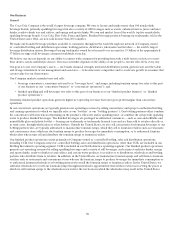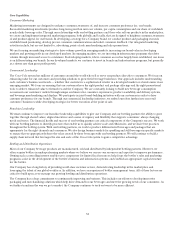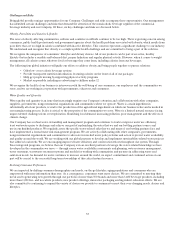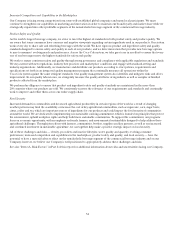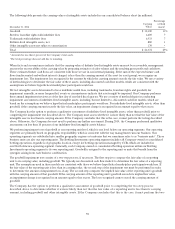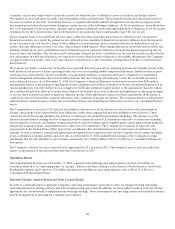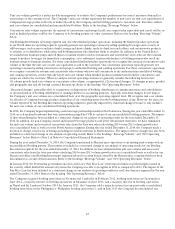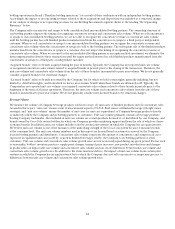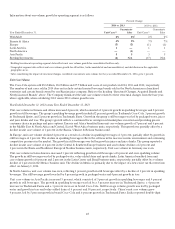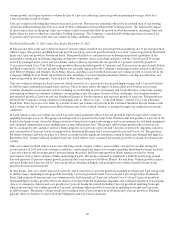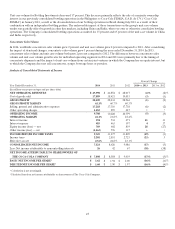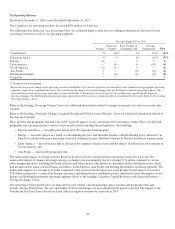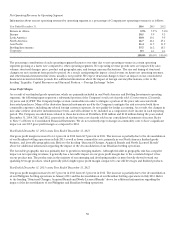Coca Cola 2014 Annual Report Download - page 42
Download and view the complete annual report
Please find page 42 of the 2014 Coca Cola annual report below. You can navigate through the pages in the report by either clicking on the pages listed below, or by using the keyword search tool below to find specific information within the annual report.40
step process. Otherwise, the Company will forego the two-step process and does not need to perform any further testing. During 2014,
the Company performed qualitative assessments on less than 10 percent of our consolidated goodwill balance.
Intangible assets acquired in recent transactions are naturally more susceptible to impairment, primarily due to the fact that they are
recorded at fair value based on recent operating plans and macroeconomic conditions present at the time of acquisition. Consequently,
if operating results and/or macroeconomic conditions deteriorate shortly after an acquisition, it could result in the impairment of
the acquired assets. A deterioration of macroeconomic conditions may not only negatively impact the estimated operating cash flows
used in our cash flow models but may also negatively impact other assumptions used in our analyses, including, but not limited to, the
estimated cost of capital and/or discount rates. Additionally, as discussed above, in accordance with accounting principles generally
accepted in the United States, we are required to ensure that assumptions used to determine fair value in our analyses are consistent
with the assumptions a hypothetical marketplace participant would use. As a result, the cost of capital and/or discount rates used in
our analyses may increase or decrease based on market conditions and trends, regardless of whether our Company’s actual cost of
capital has changed. Therefore, if the cost of capital and/or discount rates change, our Company may recognize an impairment of
an intangible asset in spite of realizing actual cash flows that are approximately equal to, or greater than, our previously forecasted
amounts. The Company did not record any significant impairment charges related to intangible assets during the year ended
December 31, 2014.
During 2013, the Company recorded charges of $195 million related to certain intangible assets. These charges included $113 million
related to the impairment of trademarks recorded in our Bottling Investments and Asia Pacific operating segments. These impairments
were primarily due to a strategic decision to phase out certain local-market brands, which resulted in a change in the expected useful
life of the intangible assets, and were determined by comparing the fair value of the trademarks, derived using discounted cash flow
analyses, to the current carrying value. Additionally, the remaining charge of $82 million related to goodwill recorded in our Bottling
Investments operating segment. This charge was primarily the result of management’s revised outlook on market conditions and
volume performance. The total impairment charges of $195 million were recorded in our Corporate operating segment in the line item
other operating charges in our consolidated statements of income.
As of December 31, 2014, we did not have any reporting unit with a material amount of goodwill for which it is reasonably likely that
it will fail step one of a goodwill impairment test in the near term. However, if macroeconomic conditions worsen or our current
financial projections are not achieved, it is possible that we may experience significant impairments of some of our intangible assets,
which would require us to recognize impairment charges. On June 7, 2007, our Company acquired Energy Brands Inc., also known as
glacéau, for approximately $4.1 billion. The Company allocated $3.3 billion of the purchase price to various trademarks acquired in
this business combination. While the combined fair value of the various trademarks acquired in this transaction significantly exceeds
their combined carrying values as of December 31, 2014, the fair value of one trademark within the portfolio has declined and now
approximates its carrying value. The operating results of this trademark for the year ended December 31, 2014, were lower than our
business plan projections for the year. If the future operating results of this trademark do not support the current near-term financial
projections, or if macroeconomic conditions change causing the cost of capital and/or discount rate to increase without an offsetting
increase in the operating results, it is likely that we would be required to recognize an impairment charge related to this trademark.
Management will continue to monitor the fair value of our intangible assets in future periods.
Pension Plan Valuations
Our Company sponsors and/or contributes to pension and postretirement health care and life insurance benefit plans covering
substantially all U.S. employees. We also sponsor nonqualified, unfunded defined benefit pension plans for certain associates and
participate in multi-employer pension plans in the United States. In addition, our Company and its subsidiaries have various pension
plans and other forms of postretirement arrangements outside the United States.
Management is required to make certain critical estimates related to actuarial assumptions used to determine our pension expense and
related obligation. We believe the most critical assumptions are related to (1) the discount rate used to determine the present value
of the liabilities and (2) the expected long-term rate of return on plan assets. All of our actuarial assumptions are reviewed annually.
Changes in these assumptions could have a material impact on the measurement of our pension expense and related obligation.
At each measurement date, we determine the discount rate by reference to rates of high-quality, long-term corporate bonds that
mature in a pattern similar to the future payments we anticipate making under the plans. As of December 31, 2014 and 2013, the
weighted-average discount rate used to compute our benefit obligation was 3.75 percent and 4.75 percent, respectively.
The expected long-term rate of return on plan assets is based upon the long-term outlook of our investment strategy as well as
our historical returns and volatilities for each asset class. We also review current levels of interest rates and inflation to assess
the reasonableness of our long-term rates. Our pension plan investment objective is to ensure all of our plans have sufficient


